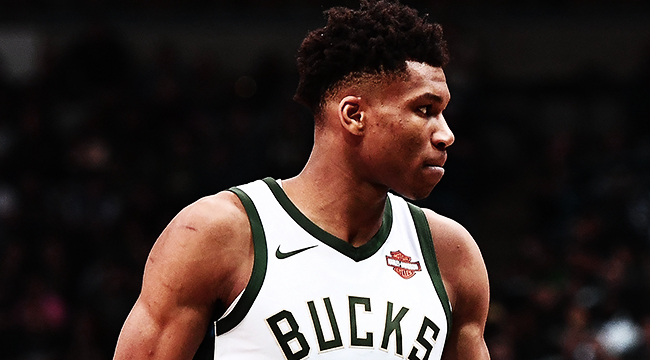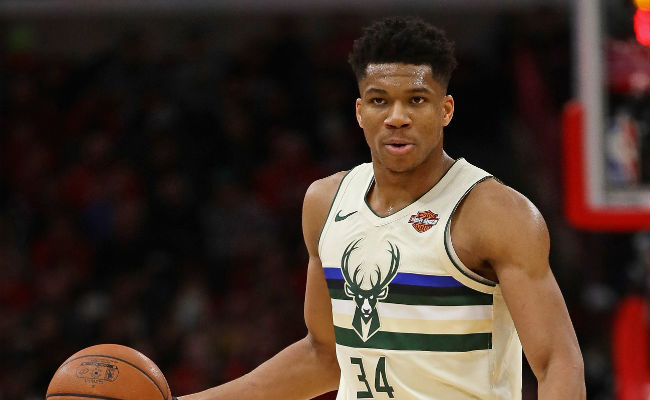
While the rest of us are going on vacation and enjoying the warm weather, the summer is a crucial time for individual skill development in the NBA. Whether it’s getting stronger and leaner, working out the weaknesses in their game, or adding an entirely new skill to the arsenal of weapons, NBA players are working just as hard in August as they do in February, all in pursuit of making May and June as easy as possible.
Even bonafide superstars are in gyms all over the world, working with specialized trainers to elevate their game and come back even better than they were just a few months ago. Giannis Antetokounmpo is no exception, as #MuscleWatch has reached the shores of Greece.
While this is a fun and kind of terrifying development, the more important work Antetokounmpo is doing will happen on the court rather than in the weight room.
In some ways, Antetokounmpo’s game is a harken back to the power forwards of old. Due to the lack of a jumper from the perimeter, there are striking similarities between his game and that of stars like Charles Barkley — Antetokounmpo lives in transition, isolations, and the post offensively. Of course, Antetokounmpo is also the post-modern power forward, because in addition to all of the above, he’s also the primary ball handler for the Bucks and sees almost as many pick-and-roll possessions as he does post-ups.

The final frontier for him is to add a reliable jumper, though there’s a gap between his current ability and where he’ll need to be to command respect from opposing defenses when he’s handling the ball beyond the arc. The jumper may come along at some point, but meanwhile, Antetokounmpo has room for improvement elsewhere, specifically in the post.
At the outset, it must be said that criticizing Antetokounmpo’s post game is the definition of nitpicking. He’s already an above-average post-up player on a very high volume, and given his absurd offensive versatility, focusing too much of his offseason work on a relatively low-efficiency area likely isn’t the best use of his time. That being said, if new Milwaukee head coach Mike Budenholzer is going to deploy Antetokounmpo in the post, it would serve him well to have a bit more in his arsenal on the block than he currently possesses.
As things stand, Antetokounmpo loves to go to his right shoulder for fadeaway jumpers and drop steps, really only going the other way if the defense pushes him in that direction. In 2017-18 (including the playoffs), he went right shoulder on more than 70 percent of his post touches, according to Synergy. While those possessions were mostly pretty efficient, having a counter move back toward his left shoulder would open things up in a big way for him.
He did have some success going to his left shoulder, especially on the right block, where he could spin baseline and attack the rim. But when a bigger defender was able to stand him up, he had trouble with his righty hook. A move that would be a welcome addition to his skill set is a turnaround jumper over his left shoulder, something mastered by Warriors guard Shaun Livingston.
Antetokounmpo, with his immense height and length, has a physical advantage over almost every matchup in the post, much like Livingston does when he enters games. Livingston has remade his game to highlight his post scoring, which includes an unblockable jumper.
Livingston gets great extension on his jumper, releasing the ball quickly and high above his head. Compare that with Antetokounmpo’s turnaround jumper.
Adopting Livingston’s turnaround isn’t possible for everybody, but Antetokounmpo already has a relatively high release on his left shoulder jumper and with a few small tweaks, it could become a go-to move, one that leads to a near-automatic two points when he busts it out. He already fakes the right shoulder spin before going to the left shoulder, which opens up the necessary space for him to elevate and fire.
The last component is getting more comfortable with the touch from that distance and getting the shot off faster. Part of what makes Livingston’s jumper impossible to stop is that it’s one motion, allowing him to elevate and fire quickly and with as little arm movement as possible. Antetokounmpo, on the other hand, elevates more slowly in these situations and shoots the ball on the way down.
Even if he improves in this area, this may only be a small a part of Antetokounmpo’s overall game. He may not use the left shoulder turnaround jumper more than once a game if he were to develop it fully; it’s not like he would have to rely upon it as heavily as Livingston does. He’ll still be in the MVP conversation in the very near future — he’s too good in almost every facet of the game for that not to be true.
But when the playoffs arrive and teams are heavily scouting Antetokounmpo and the Bucks, his one-sidedness in the post may come back to bite them. At the very least, incorporating this into his skill set would somehow make the Greek Freak even harder to defend, a scary proposition for the other 29 teams in the NBA.






